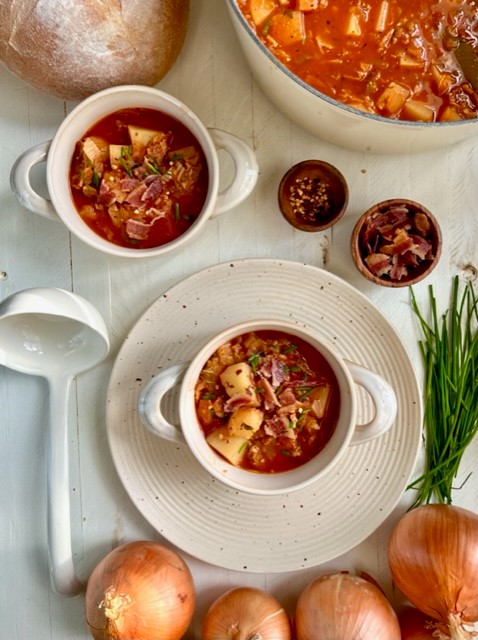
Potato Bacon & Cabbage Stew in a Spicy Tomato Sauce
Greenfield Natural Meat Co. was founded in 2015 with the goal to make sustainable meat attainable. A meat brand with a purpose, and just like me, they are focused on making the world a better place. They exist to make a better world by making meat right - better food, better care for our animals, better communities, and a better planet. They are my go-to bacon of choice because, like you, I want my kitchen table to be around for generations.
INGREDIENTS
- 6 slices of bacon (I use Greenfield Natural Bacon Co.)
- 1 medium onion, diced
- 4 cloves of garlic
- 2 tsp Herbes de Provence (Italian seasoning can also be substituted)
- 1 tsp each salt and pepper
- 6 cups chicken stock
- 1 can crushed tomatoes
- 1 cup tomato sauce with chili peppers (I use Pomi's brand)
- 3 large russet potatoes, cubed
- 1/2 tsp red pepper flakes (or more)
- 2 bay leaves
- 4 cups cabbage, shredded
- Several sprigs of thyme bound together
INSTRUCTIONS
-
Add bacon to a large dutch oven. Fry until crispy, then transfer the bacon to a paper towel-lined plate leaving 2-3 tbsp of the bacon grease in the pot.
-
Add the onion to the pot and sauté for 3-4 minutes over medium-high heat. Add garlic, Herbes de Provence, salt, and pepper, Cook for one minute or until herbs are fragrant.
-
Add the chicken stock, crushed tomatoes, tomato sauce, red pepper flakes, and potatoes to the pot. Increase the heat to high and bring it to a boil.
-
Once it's boiling, reduce the heat and simmer with the lid slightly ajar for about 20-25 minutes or until the potatoes are tender.
- Stir in the cabbage and bacon and cook for another 3-5 minutes or until the cabbage is just wilted.
-
Season with salt & pepper as needed. Serve and top the bowls with the rest of the bacon.
